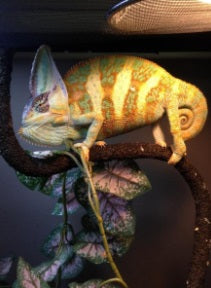Preventing Metabolic Bone Disease in Reptiles

Metabolic bone disease is one of the most commonly occurring diseases found within the reptile husbandry hobby. This disease is most often witnessed in animals with extreme imbalances or lack of Calcium and Vitamin D, or abnormally high phosphorous levels within their body. This can most commonly be the fault of an unsubstantial diet or failing to provide proper lighting for an animal with UVB requirements.
There are a multitude of species that are affected more often than others; however, those primarily dependent on a diet of insects and or vegetables are more at risk than those which consume entirely mammalian prey. Despite the severity of this disease, it is relatively easy to avoid with the right steps and precautions.
With those dietary applications noted, those that are most at risk seem to be diurnal and omnivorous lizards as well as most terrestrial turtle and tortoise species. These animals are the most common in the hobby to require the earlier mentioned UVB lighting, as opposed to most species of snakes which are generally nocturnally active and are far more lenient with their dietary or supplemental needs.
Early symptoms of metabolic bone disease in your pet are fairly easy to spot due to the abnormal shift from their regular behavior, and if identified early enough, can be turned around for the better of your animal.
Symptoms of Metabolic Bone Disease
Generally speaking, early symptoms can include physical attributes such as bowed or deformed legs (usually at the bends of the elbows being the most obvious portion), extreme levels of inactivity, and loss of any inclination to eat, followed by a loss of weight.
In extreme cases the disease is most prominently visible within the animal’s head, which can swell -- especially along the jawline -- coining the term ‘Rubber Jaw’, where the bottom jaw of the reptile (most often lizards) will become very weak and sag from the top jaw creating an incredible difficulty in the animal’s ability to catch and consume prey.
In turtles, one of the most common physical differences caused by metabolic bone disease is the deterioration of the carapace (top of the shell) from the center out, or sagging internally, or flaring of the outer edge to the point where it's almost bent in an upward direction.
- Bowed or deformed legs
- Lethargy or inactivity
- Loss of appetite or decreased eating
- Weight loss
- Swelling of the head or jaw
- Weakening, sagging, deteriorating, or flaring shell
A proper diet can help avoid Metabolic Bone Disease
A proper diet for these animals consists of appropriate parts calcium to phosphorous. Supplements of Vitamin D3 need to be provided to animals specified to require it. Finding your pet’s specific dietary requirements is as easy as locating a care sheet on the specific species.
Offering your omnivorous pets a delightful and extensive mix of vegetables can be an enormous first step in the prevention of metabolic bone disease. Offering them foods high in vitamin levels and avoiding vegetable options like excessive iceberg lettuce or habitually feeding an animal a routine of one specific vegetable.

In entirely carnivorous species of lizards, this can be avoided by sprinkling crickets with any calcium or vitamin D supplement that can be found at a pet store with a reptile section. This method of cricket preparation is usually referred to as ‘dusting’ which can be as simple as putting your crickets into a cup prior to feeding and shaking them up. Properly dusted crickets will look somewhat similar to a freshly molted cricket, being entirely white in coloration from a good coating of vitamin powder.
By meeting your pet’s specific dietary needs, you not only keep your pet looking and feeling healthy, but you'll dramatically affect the activity levels of your animal within its cage, which in turn makes for a far more rewarding pet experience.
Lighting plays a crucial role in preventing MBD in reptiles
You should also pay very close attention to an animal's lighting requirements and be absolutely certain that you can provide this prior to purchasing an animal. Animals that need UVB lighting most often need about twelve hours of daily exposure to UVB rays. For some species, this is in addition to a basking bulb for heat due to the fact that UVB lights usually don’t have high heat output.
The most common scale of UVB lighting on the shelves of your local pet shop are either labeled 5.0 UVB or 10.0 UVB. Roughly summarized, the 5.0 is intended for the housing of tropical species such as chameleons or water dragons, where in the wild they are exposed to the sun in small bursts and usually have a tree cover buffering the intensity of the sun’s rays and their basking area.
The 10.0 is more for species of animals that come from desert or scrub habitats, much like bearded dragons and most tortoise species. This is a far more intense UVB light to better replicate how the sun would naturally beat down upon them in their respective habitats.
Metabolic bone disease can be very easily avoided with proper interest and care within your pet’s health requirements. Making the effort to spare your pet from it’s wrath will provide you and your animal with a happy and healthy relationship.
Before purchasing an animal, you should always research or ask an associate if the animal has UV or supplemental requirements from the get go. This information can be found on both digital or hard copies of reptile care sheets, very much like the ones we offer in our store for free!
Don’t ever be shy to ask about any of the many products we have here at Pets On Broadway that will help you prevent metabolic bone disease in your pets!


